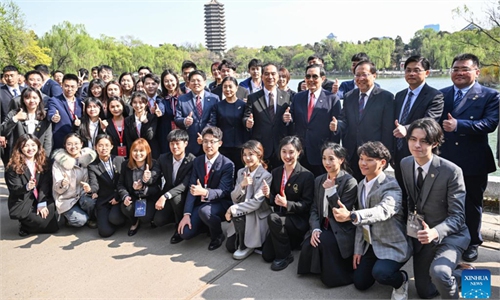ARTS / CULTURE & LEISURE
Root-finding journey for Taiwan youth

Illustration: Chen Xia/Global Times
Practicing the centuries-old Chinese martial art Tai Chi at Peking University in Beijing, visiting the Museum of Dr. Sun Yat-sen in Zhongshan, South China's Guangdong Province, touring the Emperor Qinshihuang's Mausoleum Site Museum in Northwest China's Shaanxi Province… Members of a delegation of young people from Taiwan led by Ma Ying-jeou, former chairman of the Chinese Kuomintang party, have immersed themselves in a cultural feast during their visit to the mainland.
More importantly, the journey of exchanges, cultural understanding, and historical commemoration has underscored the deep-rooted connections between Taiwan and the mainland, highlighting the shared heritage and cultural bonds between both sides of the Taiwan Straits.
During their visit to Peking University on Tuesday, Ma said, "To promote cross-Straits exchanges between students is the most important original intention of my visit and is also the goal of my efforts."
Arriving in Shenzhen on April 1, the delegation visited the provinces of Guangdong and Shaanxi as well as Beijing. The visit included several key activities aimed at fostering cross-Straits youth exchanges and deepening the understanding of the shared root and cultural lineage of people on both sides of the Straits.
The Qingming Festival, or Tomb-Sweeping Day, fell on April 4 this year. Qingming is not only one of the 24 Solar Terms of the traditional Chinese calendar but also a traditional ancestor-worship festival. The legendary Huangdi, or Yellow Emperor, is considered the founder of the Chinese civilization and the common ancestor of all Chinese people. A ceremony to pay homage to Huangdi was held in Huangling county, Shaanxi Province, on the day of the Qingming Festival.
Along with around 400 other people, including overseas Chinese, the delegation attended the grand ceremony. This act of commemoration was a powerful reminder of the deep historical and cultural ties that bind the Chinese nation together.
Amid the sounds of bells and drums, which were used as musical instruments in ancient China, participants offered flower baskets to Huangdi during the ceremony. One of the rituals of the ceremony was to plant Chinese thuja with their own hands. Since the 1980s, Taiwan compatriots who come to pay tribute to Huangdi have planted a forest named "Siyuanlin" (literal translation: forest of thinking about roots). It has become a striking example of the shared roots on both sides of the Straits.
The new seedlings planted by the delegation are a renewed symbol of inheritance of the shared roots across the Straits.
"Through this rare opportunity, young people from Taiwan can better remember the roots of Chinese culture and the Chinese nation, as well as the pride of being descendants of Yandi (who, along with Huangdi, is also widely seen as the common ancestor of all Chinese people) and Huangdi," said Ma after the ceremony.
The China Times, a Taiwan-based daily, published an editorial pointing out that ancestor worship itself reflects the history, blood relationship and emotional connection between the two sides of the Straits.
During Ma's eight years as leader of the island of Taiwan, he held six ceremonies in Taipei to worship Huangdi.
The worship ceremony in Huangdiling county marks his first time attending such an event in the mainland.
Wang Wenlung, curator of the Kuomintang Cultural and Communications Committee KMT Party History Institute, noted that many people in Taiwan know that Huangdi is the ancestor of China. Compared with holding a ceremony in Taiwan island, experiencing such a grand ceremony in person can allow young students to appreciate the long history of the Chinese nation that has lasted for thousands of years, as well as the traditional Chinese virtues of respecting ancestors and remembering the virtues of ancestors. It will surely enhance their recognition and pride in their shared roots.
Throughout the visit, the delegation made stops in various significant locations, including Guangdong, Shaanxi, and Beijing, engaging in activities that ranged from academic exchanges at prestigious universities to visiting historical sites and modern technological enterprises.
This diverse itinerary not only showcased the rich cultural and historical heritage of China but also highlighted the rapid development and technological advancements in the mainland, evoking admiration and fostering a sense of pride in the shared achievements of the Chinese people.
The delegation's visit bridges gaps in understanding.
It marks a step toward fostering a greater understanding and kinship among the younger generations across the Straits, encouraging them to explore their common heritage and build a future characterized by peace, cooperation, and mutual respect.
The author is a reporter with the Global Times. life@globaltimes.com.cn

